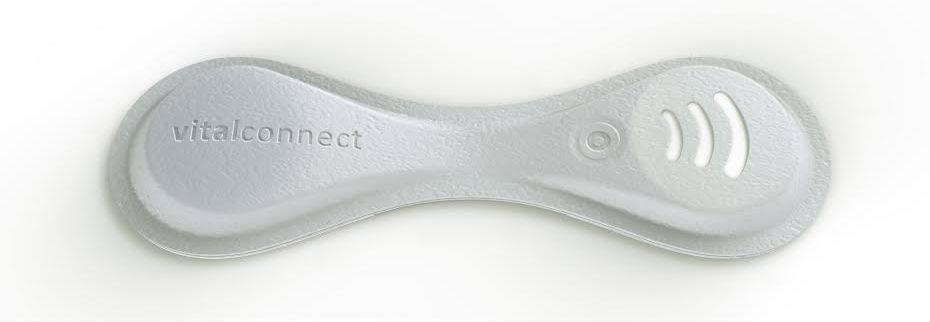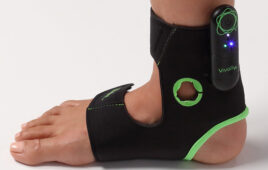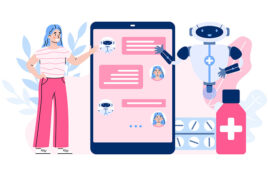I expect you’ll tire of hearing it soon, but healthcare trends have been pointing toward mobile or home adoption of patient monitoring technologies that are traditionally staples of the hospital. (A number of exhibitors at the recent MD&M West show in Anaheim confirmed this trend, as many of their components were designed for adoption in portable devices.)
What with the ever-rising costs of healthcare, it’s not hard to understand why manufacturers and patients alike embrace this movement. If the same measurements made by a bunch or large, expensive machines can be made by a smaller, friendlier device worn at home or on the go at a fraction of the cost of a hospital stay, and the technology might actually be able to prevent a future hospital stay, it’s certainly worth looking into.
That said, one company, Vital Connect, has made it a mission to develop a device that permits access to continuously transmitted health data comfortably made from either the home or the hospital. They have developed VitalPatch, a small, accurate, FDA-cleared clinical-grade biosensor that made its debut in this year’s HIMSS Annual Conference & Exhibition. I spoke with Nersi Nazari, Vital Connect’s chairman and CEO, and Valeska Schroeder, Vital Connect’s senior VP of product management, to gain some insight on VitalPatch, and how it can transform care for patients and work for healthcare professionals.
Before and After
For those who may be unaware of VitalPatch’s origins, its parent technology is called HealthPatch MD. It was intended mainly for continuous patient monitoring for patients with chronic conditions: short-term applications once a patient has been discharged from the hospital, or as follow-up care after an emergency room visit of a non-critical nature. It came onto the scene in the middle of 2014, when it first received FDA clearance. The patch is currently the only FDA-approved single-use patch of its kind cleared to make the eight separate measurements it takes. A few months thereafter, it was cleared to monitor patients in their homes.
HealthPatch’s guts featured a variety of sensors: a three-axis accelerometer for motion detection (for body posture, fall detection, and activity tracking), single-lead electrocardiogram (ECG) electrodes (for heart rate, heart rate variability, and respiratory rate), and a thermistor to measure skin temperature. Altogether, these sensors were able to provide a set of fairly comprehensive biometrics without the hassle of cumbersome machines or wires. But the company realized there were some issues that needed to be improved upon.
“HealthPatch had a module that couldn’t be thrown away,” said Nazari. “Because of the cost, you could only throw away the patch and had to keep the electronics. The sensor module was based on commercially available electronic components, very expensive to just throw away.”
The goal was to make the device entirely disposable, and thanks to improvements in the design of VitalPatch’s sensor module, this was able to occur. “Single-use disposable form factor is a lot more popular in most applications, due to ease of use and eliminating any risk of infection to the patient,” said Nazari. “Thanks to the new processor, not only does the electronic footprint shrink to make VitalPatch smaller, but now the electronics can be thrown away along with the patch after a single use due to much lower cost.”

Continuous patient monitoring can help to prevent the risk of ICU times and longer lengths of stay, as well as benefit patients economically. (Courtesy of Vital Connect)
Signifying a Change in Patient Care
“This type of technology will essentially create a new paradigm for the patient,” said Nazari. “Patients may be able to be discharged sooner, reducing costs of healthcare. Early intervention will make an enormous difference—those with conditions that require constant monitoring, like congestive heart failure or COPD, could save time and money if an adverse event were caught in time. It might save them a time-consuming and costly trip to the hospital.”
VitalPatch’s inception continues the trend of healthcare technology supporting remote or home use, but it could potentially make the jobs of both healthcare professional and patient much simpler in the hospital, as well.
“VitalPatch will be able to take measurements and make analyses that can’t be done by an occasional check,” said Nazari. “It may be able to identify things that a nurse couldn’t, perhaps catching a health problem up to ten days in advance of an adverse event. Also, it could help nurses and caregivers alike by allowing them to simply look at numbers on a monitor to determine targeted care.”
But the technology means nothing if people don’t want to use it. One of the targets for this technology is the elderly, a group notorious for difficulties grasping new technology. One of Vital Connect’s trials enrolled 76 patients that were an average of 69 years old. They were expected to use the patch at home for 50 days, for a wear cycle of three days. They were encouraged to stick to daily routines, with 50 disposable patches, a reusable electronic module, and a mobile device to capture wireless data. The trial participants were able to change the patches at home, including discontinuation and resumption of data.
“With the elderly in mind, we made VitalPatch as friendly as possible,” said Schroeder. “It’s easy to use and pair with a mobile device. In one trial, 76 elderly patients were able to use the device without too much trouble.”
Expanded Applications
The suite of measurements VitalPatch takes opens the door to gathering data on medical conditions that require the interpretation of complex data sets based on a variety of biometrics. One such example is sleep apnea, which typically requires a sleep study to make a conclusive diagnosis—anyone who’s undergone a sleep study can tell you that it becomes quite a stressful affair, what with being connected to several machines by wires that don’t exactly encourage a restful night’s sleep.
While it’s still too early to say whether technology like VitalPatch would be able to replace a traditional sleep study, the technology is paving the way for sleep studies to actually be made at home, or at the very least, made much more comfortably in the hospital. “For sleep apnea, we have developed algorithms based on machine learning that made sophisticated calculations based on heart rate, heart rate variability, respiration rate and motion overnight,” said Nazari. We have validated results from our patches with these algorithms to results from sleep labs and have found 90% accuracy.”
This article appeared in the March 2016 print edition of MDT.




